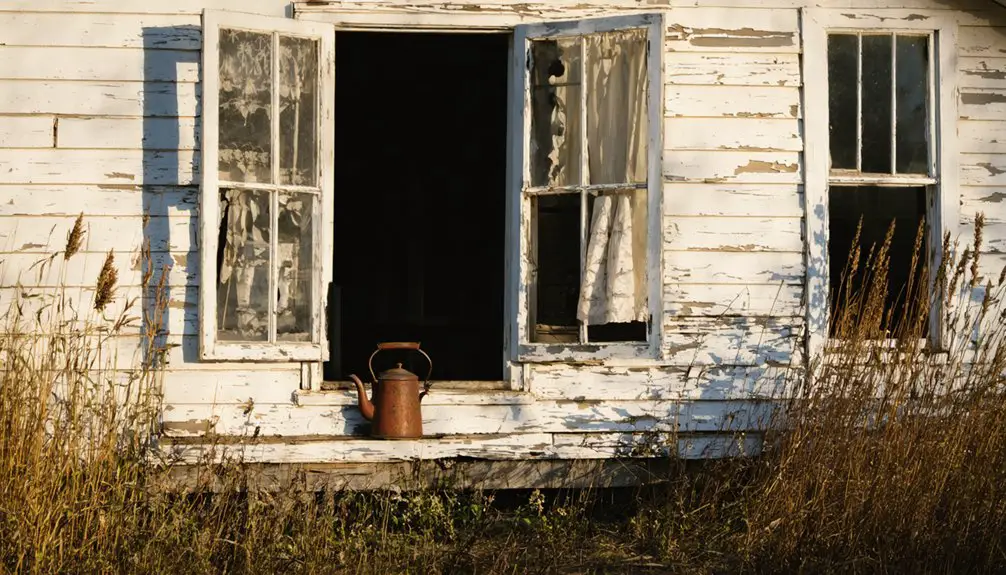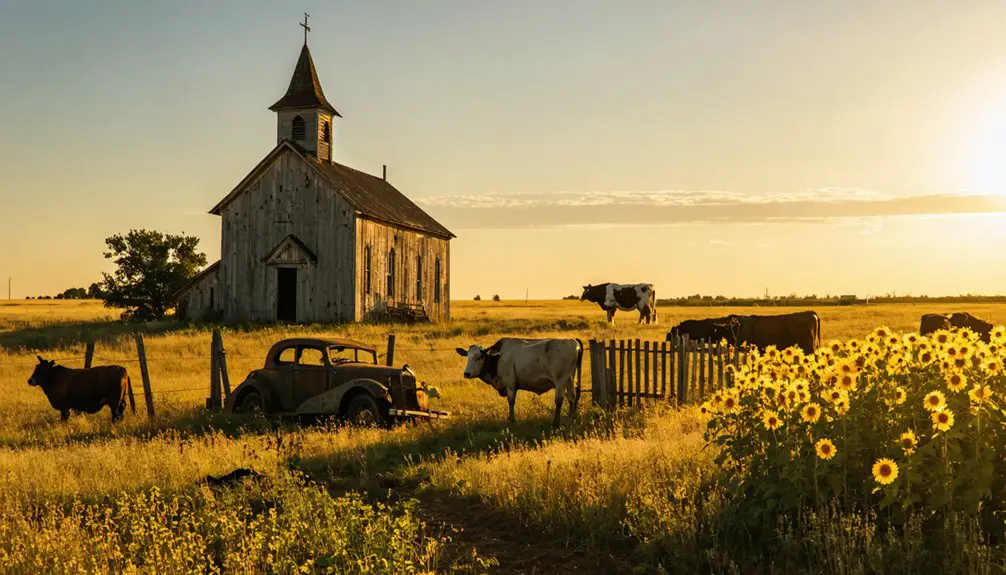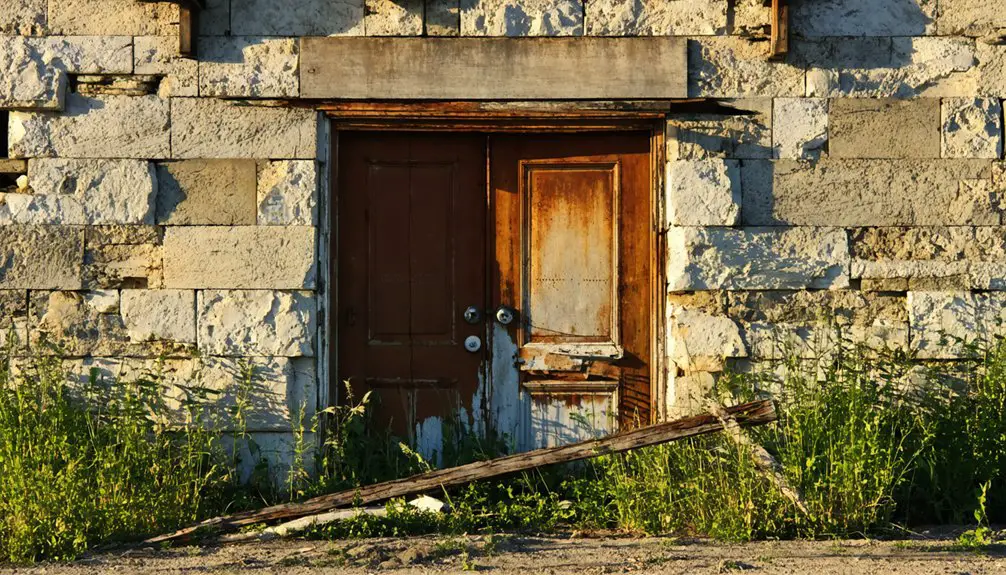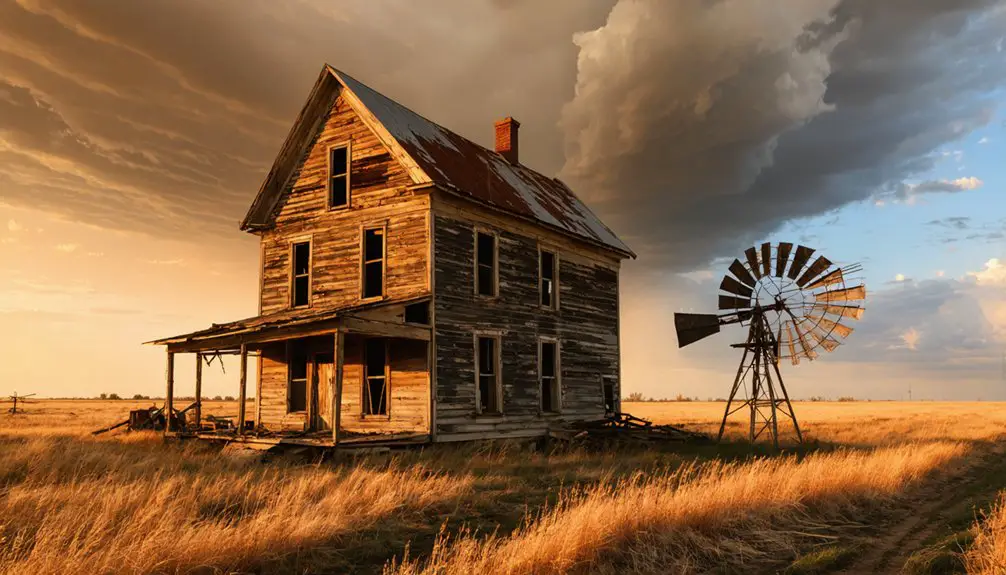You’ll find Runnymede, Kansas was a unique 1880s ghost town founded by Irish immigrant Francis J.S. “Ned” Turnley, who aimed to create an English countryside paradise on American prairie. He established a farming school for wealthy British youth, complete with English-style houses and leisure activities like polo and fox hunting. Though the town never exceeded 200 residents, its brief existence as a British social experiment offers fascinating insights into frontier cultural clashes.
Key Takeaways
- Runnymede was a failed English colony in Kansas established in the 1880s by Irish immigrant Ned Turnley to recreate British countryside living.
- The settlement featured English-style architecture, including the prominent Runnymede Hotel and estates designed for wealthy British youth farmers.
- Cultural conflicts between English leisure lifestyle and American frontier farming needs contributed to the town’s eventual downfall.
- The railroad’s decision to bypass Runnymede and withdrawal of British financial support led to the settlement’s rapid decline.
- Today, only scattered remnants remain, including the relocated church and hotel, with most of the original townsite converted to wheat fields.
A British Vision on American Prairie
When Irish immigrant Francis J.S. “Ned” Turnley established Runnymede in the late 1880s, he sought to recreate an idyllic English countryside on the Kansas prairie. His vision of prairie idealism centered on creating an agricultural education program where wealthy British youths could learn farming and ranching for $500 annually.
After purchasing 1,700 acres of land, Turnley began transforming the raw prairie into his dream settlement.
You’ll find that Turnley’s settlement wasn’t just about agriculture – it was a bold social experiment to transplant British identity onto American soil.
The town’s design reflected this vision with its curving driveways, English-style houses, and manicured hedges. Even the name “Runnymede” carried deep significance, referencing the historic site where King John signed the Magna Carta.
Turnley’s ambitious plan aimed to blend aristocratic English living with American frontier opportunities. The settlement quickly attracted 100 British settlers who were drawn to this unique vision of English country life in Kansas.
Turnley’s Grand Agricultural Experiment
Turnley’s ambitious agricultural enterprise began with the purchase of 1,700 acres at $1.50 per acre in northeastern Harper County. His vision centered on creating an exclusive farming school where wealthy English students would pay $500 annually plus living expenses to learn American agricultural methods.
You’ll find that Turnley’s vision wasn’t modest – he established an elaborate setup featuring English-style farms complete with curving driveways and meticulously clipped hedges. He marketed his venture in England, painting Kansas as a western paradise with golden birds and silver rivers. Like many farmers of the era, his students faced the arduous task of breaking an acre of sod per day using ox teams.
To demonstrate successful agricultural methods, he combined traditional English estate farming with American prairie techniques. The experiment aimed to give young British gentlemen practical training in farming and stock raising while maintaining the refined atmosphere of an English countryside estate.
The Making of an English Estate in Kansas
In late 1880s Kansas, you’d find Runnymede’s curving driveways and clipped hedges deliberately arranged to mirror the grand English estates that wealthy settlers left behind.
The town’s architectural character featured English-style houses and prominent buildings like the Runnymede Hotel, creating an aristocratic atmosphere in the American frontier. The colony’s centerpiece was a three-story frame building that housed reception rooms, dining areas, and bedrooms for residents.
You could experience the full English estate lifestyle through carefully planned farms and orchards, which complemented the manicured gardens and provided a familiar environment for British colonists spending $500 annually to learn agricultural methods. Instead of focusing on actual farming, the residents spent their time enjoying horse racing and tennis, maintaining their leisurely lifestyle from back home.
English Gardens Take Root
Under the grand vision of Francis J.S. “Ned” Turnley, Runnymede’s landscape transformed into a slice of England on the Kansas prairie. The town’s garden aesthetics reflected British sophistication, with carefully planned orchards and a dedicated tree nursery supporting the grand design. Drawing inspiration from the original Runnymede’s Thames flood plain, the Kansas site incorporated water features and meadowlands into its design. Much like the historic Cottonwood Ranch, these estates showcased distinctive English architectural and landscaping elements.
You’d find manicured hedges and ornamental species alongside functional agricultural plots, all arranged to mirror the refined atmosphere of English country estates.
- Curving driveways led through meticulously planned gardens that showcased both beauty and agricultural purpose.
- The Chicaskia River valley provided a natural backdrop, enhancing the picturesque horticultural practices.
- Estate gardens served dual roles: sustaining agriculture while providing elegant spaces for afternoon tea and social gatherings.
The landscape design seamlessly blended English rural traditions with Kansas’s natural features, creating an environment where wealthy English sons could embrace both farming and refinement.
Imported Architecture and Design
Beyond the manicured gardens, Runnymede’s architectural landscape stood as a tribute to English sophistication on Kansas soil.
You’d find buildings arranged across seven city blocks showcasing authentic English design elements, from the Gothic-styled St. Patrick’s Episcopal Church to the three-story Runnymede Hotel with its advanced heating and ventilation systems.
The colony’s imported materials and architectural authenticity were evident everywhere – from assembled stone and brick to elegant woodwork and bronze memorial plaques.
Inside the buildings, you’d discover furnishings straight from England, including the church’s baptismal font and decorative ecclesiastical fixtures.
The English aesthetics extended beyond individual structures to encompass the entire estate’s layout, with curving driveways and clipped hedges creating an unmistakable English countryside atmosphere in the American prairie.
Living Like British Nobility
While young British noblemen elsewhere inherited vast English estates, Runnymede’s residents paid $500 yearly to experience their own slice of aristocratic life on Kansas soil.
Francis J.S. “Ned” Turnley crafted a vision that catered to British aspirations, marketing the settlement as a western paradise where you’d find the nobility lifestyle transplanted onto American frontier land. The purchase of 1700 acres along the Chikaskia River provided the perfect backdrop for his ambitious plans.
- You’d discover English-style houses with sweeping driveways, designed to mirror the grand estates of Britain.
- You’d join other sons of wealthy British families in a close-knit community of gentleman farmers.
- You’d learn agriculture while maintaining the social customs and recreational pursuits of the English gentry.
The settlement aimed to preserve British cultural traditions while teaching practical farming skills, offering young nobles a unique blend of frontier opportunity and familiar refinement.
Life Among Young British Settlers

You’d find Runnymede’s young British settlers living a lifestyle of leisure, hosting elaborate parties at the Runnymede Arms hotel while maintaining their English customs in the midst of the Kansas prairie.
The community’s social life centered around the Runnymede Arms hotel, which was constructed by 1890 and became the heart of their entertainment.
Despite their wealthy backgrounds and access to family funds, these “Remittance Men” showed little interest in the agricultural training that had drawn them to Kansas in the first place.
Their days revolved around social gatherings and entertainment rather than farming, ultimately leading to failed agricultural ventures as they prioritized recreation over developing practical ranching skills.
Social Events and Recreation
Although Runnymede was established as a farming colony, its young British settlers created an environment that more closely resembled an English country estate than a typical Kansas homestead. These “remittance men” focused on social gatherings and recreational activities that reflected their aristocratic upbringing.
You’d find British sporting traditions thriving at the polo grounds, steeplechase course, and tennis courts, where settlers continued their passion for equestrian sports. Located two miles northeast of the present site, these recreational facilities were carefully designed to mirror English sporting venues.
Red-coated hunters rode to hounds across the prairie, maintaining their beloved fox hunting traditions from England.
The three-story Runnymede Arms hotel served as the social hub, where you’d experience the lifestyle of England’s upper class, complete with organized events and sporting matches.
These leisure pursuits defined the colony’s character until economic hardship and declining British investment led to its eventual abandonment.
Luxury Living on Prairie
Life among Runnymede’s British settlers reflected an opulent transplant of English aristocratic living onto Kansas prairie soil.
You’d find wealthy young Brits residing in English-style houses with manicured hedges, accessed by winding driveways that created an estate-like atmosphere. Their luxury amenities included tennis courts, a racetrack, and a three-story hotel called the Runnymede Arms.
Despite paying $500 yearly to learn farming, these settlers preferred aristocratic leisure over agricultural work. You could spot them in red coats riding to hounds across the prairie, playing polo, or participating in steeplechase races.
The community, which peaked at 100-200 residents, maintained a lifestyle more akin to a dude ranch than a settlement, complete with clipped hedges and scenic views of the Chikaskia River.
Failed Farming Aspirations
Despite paying $500 annually for agricultural training, the sons of British gentlemen who settled in Runnymede showed little interest in actual farming.
These young settlers, more accustomed to English estates, struggled with cultural adaptation on the American frontier. Instead of cultivating crops, you’d find them pursuing leisure activities and spending their family’s money.
The failed investments in Runnymede became evident through:
- A declining interest in agricultural education despite high tuition fees
- The settlers’ preference for horse racing and hunting over farming duties
- The eventual withdrawal of British financial backing as productivity plummeted
From Social Paradise to Ghost Town

When Francis J.S. “Ned” Turnley established Runnymede in 1879, he envisioned creating an English social paradise on Kansas soil.
You’d find young British gentlemen spending their days fox hunting, horse racing, and attending lavish social events – activities that clashed with the harsh realities of frontier farming.
This cultural misunderstanding between English leisure and American agricultural demands led to a swift economic downfall.
By the early 1890s, you’d see the dream unraveling as British investors withdrew their support and colonists returned home disillusioned.
The railroad’s decision to bypass Runnymede by two miles dealt the final blow.
Railroad Dreams and Economic Reality
The railroad’s promise shaped every aspect of Runnymede’s development from its inception. When Francis J.S. “Ned” Turnley established this English-inspired settlement, he envisioned the Kansas City, Mexico & Orient Railroad would make it a thriving hub.
Like many frontier dreams, Runnymede’s fate hung on the promise of iron rails that would bring prosperity and progress.
But the railroad infrastructure never materialized as planned, with tracks being laid two miles southwest instead.
You’ll find these stark economic challenges that sealed Runnymede’s fate:
- The colony’s modest capital of $4,800 couldn’t sustain the ambitious venture
- English settlers avoided hard labor, creating tension with local farmers
- The three-story hotel and Episcopal church stood as symbols of unrealized dreams
Without direct rail access, Runnymede’s promise of a western paradise for wealthy English sons faded, and the town’s population never exceeded 200 before its decline.
Relics of a Lost Community

Today you’ll find precious few physical remnants of Runnymede’s brief but colorful history. The wheat fields have reclaimed most of the original townsite, leaving only scattered community artifacts to tell the tale.
You can still trace the town’s legacy through two significant relocated structures: the original church building, which now stands in Harper, Kansas, and the old Runnymede Hotel, which was moved to Alva, Oklahoma.
A solitary historical marker along Highway 2 commemorates the lost English colony, where young British gentlemen once attempted farming but preferred horse racing and socializing.
While archaeological excavations remain limited, the documentary record preserves the town’s story through letters, property records, and newspaper accounts from its 1888-1892 heyday.
The Runnymede Hotel’s Journey
Built in just three months during late 1889, Runnymede’s magnificent hotel stood as the showpiece of this ambitious English colony in Kansas.
You’ll find this three-story marvel featured advanced amenities that set it apart from typical frontier accommodations, including modern heating, ventilation, and water closets.
- The hotel’s lavish features included three reception rooms, an ornate dining room, and 11 well-appointed bedrooms.
- It served as the social hub for grand banquets and community gatherings, while supporting daily stagecoach travelers.
- By 1893, it had expanded to 40 rooms before its dramatic hotel relocation to Alva, Oklahoma Territory.
When the English colony failed and settlers returned home, the building’s community impact continued in Oklahoma, where it stands today as a restored heritage site, preserving the legacy of this unique Anglo-American experiment.
Legacy of a Failed Colony
While the hotel’s relocation marked one chapter of Runnymede’s story, deeper issues sealed the colony’s ultimate fate.
You’ll find little evidence today of the once-promising British settlement, save for a wheat field, historical markers, and a lone tombstone.
The colony’s economic decline stemmed from multiple factors: the railroad’s rerouting two miles south, British investors who lost interest, and “remittance men” more focused on polo and parties than farming.
When the 1890s depression hit, financial support from England dwindled. Failed investments and foreclosures followed, with founder Ned Turnley ultimately returning to Ireland with remaining funds.
Though the original settlement was deserted by 1895, some British settlers adapted, finding success elsewhere in Kansas and Oklahoma.
Frequently Asked Questions
What Happened to the Native American Lands Before Turnley’s Purchase?
You’ll find that native land treaties forced the Osage Indians from their ancestral territory, while historical conflicts and federal policies transferred these trust lands to government control before Turnley’s 1880s purchase.
Did Any of the English Settlers’ Descendants Remain in Kansas?
You won’t find any descendant lineage from the English settlers in Kansas – they mostly returned to England by 1893. Their brief cultural legacy exists only in historical markers, not continuing bloodlines.
What Was the Exact Population of Runnymede at Its Peak?
While historical records tantalize with estimates, you’ll find that Runnymede reached between 100-200 residents at its 1890 peak before population decline struck, leading to its ghost town status by 1895.
Were There Any Notable Visitors or Celebrities at Runnymede?
You won’t find records of celebrity sightings or famous visitors beyond the English aristocrats’ sons who came for agricultural training. They weren’t celebrities themselves, just wealthy young men seeking adventure.
How Did Local Kansas Residents React to the English Colony?
Like watching a foreign film unfold, you’d have seen local perceptions shift from curious optimism to skepticism as Kansans witnessed the cultural exchange between English gentry attempting frontier life and failing.
References
- https://legendsofkansas.com/runnymede-kansas/
- http://therunnymede.com/history_kansas.html
- http://explorekansas.blogspot.com/2013/06/runnymede-kansas.html
- https://okielegacy.net/journal/tabloid/?ID=1293&vol=8&iss=5
- https://www.ghosttowns.com/states/ks/runnymede
- https://www.kspatriot.org/index.php/articles/48-kansas-agriculture/226-history-of-kansas-agriculture.html
- https://www.ksre.k-state.edu/historicpublications/pubs/SB001.PDF
- https://www.ksre.k-state.edu/historicpublications/pubs/R7Garden.pdf
- https://okielegacy.net/journal/tabloid/index.php?ID=8404&vol=4&iss=1
- https://www.instagram.com/p/C_DpEdqMWBG/?hl=en



